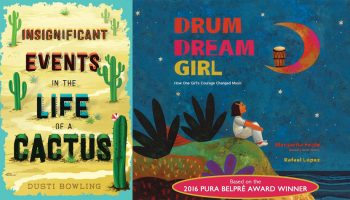For the CLSC Young Readers program in Week Three, it’s not so much about “The Art of Play,” but the playfulness in retelling an original story.
“We wanted to find books that were playful in their approach, rather than books that are about ‘playing,’ So the ‘play’ is in playing with genre convention and playing with familiar stories and characters in ways that might surprise.”
-Atom Atkinson, Director, Literary Arts
At 12:30 p.m. Wednesday, July 11, in the Pier Building, the Chautauqua Opera Company will lead a CLSC Young Readers activity on the two books selected for Week Three: Snow White, by Matt Phelan (a graphic novel retelling of the classic fairytale) and A Study in Charlotte, by Brittany Cavallaro (a new spin on the Sherlock Holmes books focusing on the crime-solving adventures of Holmes’ and John Watson’s descendants).
Karen Schiavone, manager of Special Studies and Youth Programs, said during the activity with Chautauqua Opera, “we’ll look at how we retell stories throughout history. We are always retelling stories and putting a different spin on them.”
 For example, the story of Snow White has been retold many times, Schiavone said, from the original story to the Disney movie to Phelan’s graphic novel.
For example, the story of Snow White has been retold many times, Schiavone said, from the original story to the Disney movie to Phelan’s graphic novel.
“(Phelan’s) takes place right at the beginning of the Great Depression, in New York City, … so (it’s a) very different telling of Snow White,” Schiavone said.
Schiavone said Chautauqua Opera is “uniquely suited” for helping the Young Readers explore the retelling of stories this week.
“Given the work that they do, they are not just reproducing Don Giovanni or Candide as they were originally performed,” Schiavone said. “I think every time, when any company puts on a performance … they are trying to put their name on it and make them unique in their way.”
There are two books this week because A Study in Charlotte is recommended for ages 14 and up, and is “a book that appeals a little more to young adults,” according to Atkinson.
 “As a Holmes novel, it deals with a lot of the same things Holmes novels deal with, things like criminal behavior, things that — whether they are legal or not — are questionable or dangerous…. The book is not afraid to engage with a lot of that kind of content in the lives of its teen characters here,” Atkinson said.
“As a Holmes novel, it deals with a lot of the same things Holmes novels deal with, things like criminal behavior, things that — whether they are legal or not — are questionable or dangerous…. The book is not afraid to engage with a lot of that kind of content in the lives of its teen characters here,” Atkinson said.
Atkinson said “it was important to us to make sure it was paired with a book that could be more suitable and age-appropriate for younger readers,” hence the selection of Snow White.
Snow White is a graphic novel, which Schiavone said she loves to put on the CLSC Young Readers book list.
“I thought that Snow White was just beautiful,” Schiavone said. “The artwork is just extraordinary. It really drew me in.”
Other than the beauty of the graphic novel, the pictures themselves may appeal to young readers who aren’t usually interested in books.
“I think it’s important as a way to (include) reluctant readers. Kids who might not be as likely to pick up a 300-page novel might pick up a 300-page graphic novel because it still has pictures. … I’ve already heard some feedback from parents that say, ‘Oh yeah, my kids went straight for a graphic novel, and they don’t usually pick up books,’ ” Schiavone said. “That’s very exciting to see kids who might not pick up books otherwise, get excited about the graphic novels.” Schiavone said Phelan uses the introduction of color as an interesting device throughout the book.
“It wasn’t until the second time I read it through, I realize by the end (of the story), it was in full color. It was a very slow shift. When (Snow White) was coming back to life, all of a sudden, a few things on each page start to have more color happening. By the end, it’s in full color,” Schiavone said. “So there’s your ‘happily ever after.’ You always get your ‘happily ever after’ at the end in a fairytale. I thought that was an interesting way to do that.”




